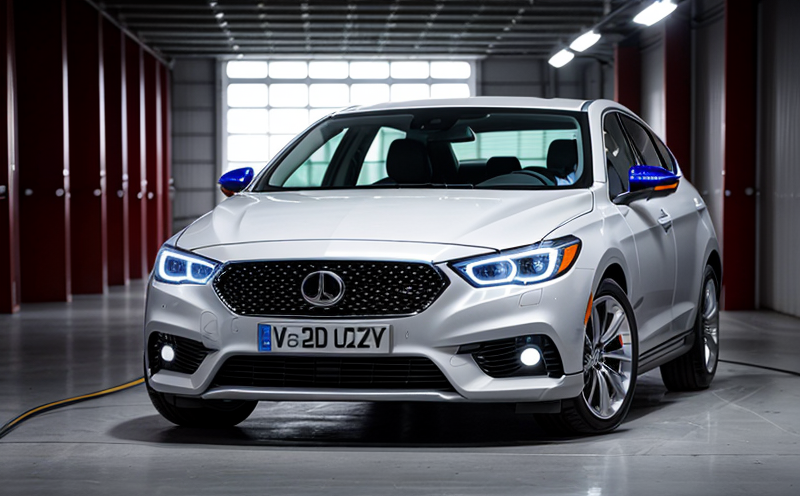ECE R148 Rear Fog Lamp Testing for Passenger Cars
The ECE Regulation No. 148 specifies the requirements for rear fog lamps installed in passenger cars and other motor vehicles. This regulation is designed to enhance road safety by ensuring that all rear fog lamps meet stringent performance standards. The primary objective of this test is to ensure that the rear fog lamp functions reliably under various environmental conditions, providing visibility to drivers and pedestrians in poor weather conditions such as fog or heavy rain.
The testing process involves a series of rigorous checks to evaluate the optical properties of the rear fog lamps, including luminous intensity, color, cutoff height, and uniformity. Compliance with these requirements is crucial for manufacturers aiming to meet international standards and ensure product safety on roads worldwide. The test procedures are outlined in ISO 6928:2017, which provides detailed guidance on how to conduct the necessary tests.
For a rear fog lamp to pass this stringent testing, it must comply with several critical parameters:
- Luminous intensity at a specified distance
- Cutoff height ensuring the light does not shine too far ahead or below the vehicle
- Uniformity of the light distribution across the required area
- Color consistency to ensure visibility and safety
The testing apparatus used in ECE R148 includes a darkened room, a standard test stand, a photometer, and other specialized equipment designed to replicate real-world driving conditions. These tests are conducted under controlled environmental conditions to simulate the operational environment of fog lamps in various weather scenarios.
Manufacturers must ensure that their rear fog lamps undergo thorough testing before they can be certified for sale within countries that adhere to ECE R148 requirements. This includes not only meeting the technical standards but also providing documentation and data that demonstrate compliance with these regulations.
The significance of this test extends beyond just regulatory compliance. It plays a critical role in enhancing road safety by ensuring that vehicles are equipped with reliable lighting systems capable of improving visibility under challenging driving conditions. Compliance with ECE R148 helps manufacturers build trust with consumers and regulatory bodies, thereby facilitating smoother market entry into countries that require this certification.
Given the importance of rear fog lamps in improving road safety, it is essential for manufacturers to invest in robust testing methodologies to ensure their products meet all specified requirements. This includes not only adhering strictly to international standards but also continuously updating and refining test protocols based on technological advancements and changing environmental conditions.
By focusing on thorough testing of rear fog lamps according to ECE R148, manufacturers can contribute significantly to reducing accidents caused by poor visibility during adverse weather conditions. This commitment to safety not only benefits consumers but also supports the overall goal of promoting road safety globally.
Industry Applications
| Application | Description |
|---|---|
| Rear Fog Lamps in Passenger Cars | Ensuring visibility under fog and heavy rain conditions is critical for passenger cars. Testing according to ECE R148 ensures compliance with international standards, enhancing road safety. |
| Commercial Vehicles | The testing criteria are similar but may vary slightly depending on the specific requirements of commercial vehicles. This includes trucks and buses where rear visibility is equally important. |
| Light Commercial Vehicles (LCVs) | LCVs also require compliance with ECE R148 to ensure that their rear fog lamps meet the same rigorous standards as passenger cars, further enhancing road safety. |
The testing of rear fog lamps according to ECE R148 is not limited to just passenger cars but extends to various types of vehicles where rear visibility can be compromised. This includes commercial and light commercial vehicles which are equally subject to the same stringent tests. By ensuring that all vehicles meet these standards, manufacturers contribute significantly towards reducing accidents caused by poor visibility in adverse weather conditions.
International Acceptance and Recognition
The ECE R148 rear fog lamp testing is widely recognized and accepted across numerous countries that adhere to the European Economic Area (EEA) standards. This includes not only member states of the EU but also other nations like Switzerland, Turkey, and Norway, which have adopted these regulations.
Compliance with ECE R148 ensures that rear fog lamps meet the highest safety and performance standards recognized globally. The rigorous testing process helps manufacturers comply with international norms and gain entry into markets where this certification is mandatory. This not only enhances product reliability but also builds trust among consumers and regulatory bodies.
The widespread acceptance of ECE R148 underscores its importance in promoting road safety by ensuring that vehicles are equipped with reliable lighting systems capable of improving visibility under challenging driving conditions. Compliance with these standards helps manufacturers build a strong reputation for producing safe and dependable products, thereby facilitating smoother market entry into countries that require this certification.
Competitive Advantage and Market Impact
- Enhanced Safety: Meeting ECE R148 requirements demonstrates a commitment to road safety, which is highly valued by consumers.
- Global Reach: Compliance with international standards opens up new markets for manufacturers who are already certified under this regulation.
- Trust and Reputation: Demonstrating adherence to stringent testing protocols builds trust among regulators and the public.
- Technological Leadership: Investing in robust testing methodologies positions a manufacturer as a leader in technological innovation within the industry.
The ability to comply with ECE R148 not only provides manufacturers with a competitive edge but also supports their efforts towards promoting road safety. By ensuring that rear fog lamps meet all specified requirements, manufacturers can confidently enter new markets while maintaining high standards of quality and reliability.





